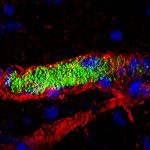Lien vers Pubmed [PMID] – 24864127
EMBO J. 2014 Aug;33(16):1767-83
As mediators of adhesion, autoaggregation and bacteria-induced plasma membrane reorganization, type IV pili are at the heart of Neisseria meningitidis infection. Previous studies have proposed that two minor pilins, PilV and PilX, are displayed along the pilus structure and play a direct role in mediating these effects. In contrast with this hypothesis, combining imaging and biochemical approaches we found that PilV and PilX are located in the bacterial periplasm rather than along pilus fibers. Furthermore, preventing exit of these proteins from the periplasm by fusing them to the mCherry protein did not alter their function. Deletion of the pilV and pilX genes led to a decrease in the number, but not length, of pili displayed on the bacterial surface indicating a role in the initiation of pilus biogenesis. By finely regulating the expression of a central component of the piliation machinery, we show that the modest reductions in the number of pili are sufficient to recapitulate the phenotypes of the pilV and pilX mutants. We further show that specific type IV pili-dependent functions require different ranges of pili numbers.

